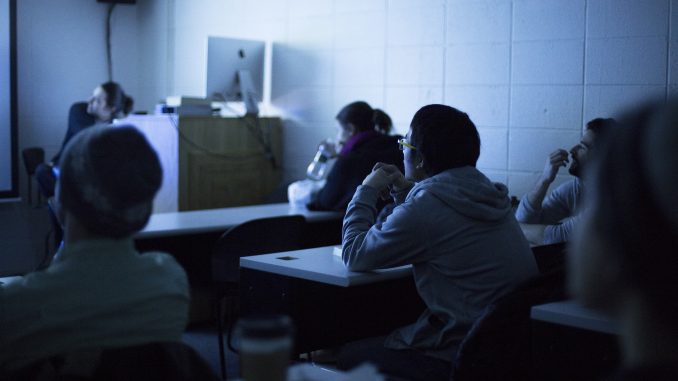
As senior year comes to a close and students prepare for jobs and post graduation life, experience in a student’s field of study becomes a major component to landing a job right out of school.
The 13 seniors in the Department of Film and Media Arts’ year-long Senior Projects class are getting an early start.
Students in the course spend their fall and spring semesters producing a short film under the instruction of assistant professor Lauren Wolkstein and adjunct assistant professor David Romberg. In May, the films students produce will be presented at the 16th annual Diamond Screen Film Festival, an annual showcasing of students’ work from the Film and Media Arts program.
However, there are many steps to achieving a finished final product, Wolkstein said. The process begins in April, when students apply for the class by submitting a written script detailing the plans for their film.
Wolkstein, an award-winning filmmaker from Baltimore who is in her first year teaching at Temple, said the script is a key part to the process.
“If the script isn’t prepared or thought out, then you shouldn’t be working on the project,” she said. “There are a lot of steps the film goes through, and if the script isn’t strong, then it will fall through.”
If a script is accepted, the student is enrolled in the course, which is split up into three sections for each semester. In the fall, sections include script revisions, storyboarding and preproduction.
Because students are tasked with spending their winter break recording their film, the fall semester can be very rigorous, intense and full of planning, Wolkstein said. Wolkstein’s students are paired with student producers from other classes in the Film and Media Arts department, so students can share and ease the workload.
Because all other film classes end after the fall semester, unlike Senior Projects, the partnerships created between students across classes is lost halfway through the year. Wolkstein says she wants to see this change with the addition of a Bachelor of Fine Arts next fall.
“The student producers that partner up with us are arranged through my communication with other professor’s and their classes,” Wolkstein said. “The department doesn’t have a system to set that up yet, so I take care of it on my own. Next year there will be a Bachelor of Fine Arts program, so a producing class will then be paired for the whole year.”
Raymond Karpinsky, a student enrolled in the class, agrees that a more structured partner system could benefit students.
“Some student producers come into the project not realizing how much work it really is,” Karpinsky said. “I don’t think they always know exactly what they are getting into, so that can make them become less involved and take it less seriously. If there is a course that tells them exactly what they will be doing, it could really help the process.”
Because all of the students are asked to film over break, many said it is difficult to reserve film equipment from the Equipment Office, located in Room 101 of Annenberg Hall, when the demand is so high.
After winter break, most students are ready to begin the post-production stage of the course and they begin preparing their work for the final product.
Instead of revising and planning, the focus of the class shifts to editing, restructuring and providing feedback, and students focusing on editing, fixing film, sound mixers and color correctors.
When all students in the class have produced a rough cut of the film, they critique each other’s work. After receiving advice and suggestions from the class, students then prepare a fine cut of the film to be shown and critiqued by the class again.
“A lot of the spring semester is spent critiquing and giving feedback on everyone’s film,” Wolkstein said. “Instead of producing and creating, we shift to executing and distributing the final work.”
When all is said and done, students who complete the class leave with a finished short film to add to their portfolio. Wolkstein says this is critical to students’ success after they graduate.
“If a student wants to take the film to an independent filmmaker, studio or any other outlet, they have a great sample to show them,” she said. “If they put their finished product in the right places, it will be a huge help in starting their film careers.”
Andre Dienner can be reached at andre.dienner@temple.edu.



Be the first to comment